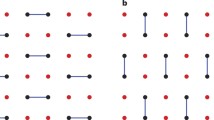Abstract
A quantum Turing machine is considered. A review of basic methodological principles and achievements in the field of quantum computations is given. Some problems of construction of correct quantum computations and their complexity are considered. The result of P. Shor concerning the solution of the problems of taking discrete logarithms in polynomial time relative to the length of numbers is considered in detail.
Similar content being viewed by others
References
A. V. Anisimov, “Classical and applied theories of algorithms,” Models and Information Systems, No. 5, 3–7 (1986).
A. V. Anisimov, “Recursive information transducers: Computation models,” Kibern. Sist. Anal., No. 4, 30–47 (1998).
R. Feynman, “Simulating physics with computers,” Int. J. Theor. Phys., No. 21, 467–488 (1982).
D. Deutsch, “Quantum theory, the Church-Turing principle, and the universal quantum computer,” in: Proc. of the London Royal Soc, No. A400, 97–117 (1985).
E. Bernstein and U. Vazirani, “Quantum complexity theory,” in: Proc. 25th ACM Symp. on Theory of Comput., San Diego, USA (1993), pp. 11–20.
D. Simon, “On the power of quantum computations,” in: Proc. of the 35th Ann. Symp. on Found, of Comput. Sci., IEEE Press. (1994), pp. 116–123.
P. Shor, “Algorithms for quantum computations: Discrete logarithms and factoring,” in: Proc. of the 35th Ann. Symp. on Found. of Comput. Sci., IEEE Press., (1994), pp. 124–134.
A. Yao, “Quantum circuit complexity,” in: Proc. of the 34th Ann. Symp. on Found. of Comput. Sci., IEEE Press, (1993), pp. 352–361.
A. Aho, J. Hopcroft, and J. Ullman, The Design and Analysis of Computer Algorithms [Russian translation], Mir, Moscow (1979).
C. H: Bennett, “Logical reversibility of computations,” IBM J. Res. Dev., No. 17, 525–532 (1973).
D. Aharonov, A. Kitaev, and N. Nisan, “Quantum circuits with mixed states,” in: Proc. of the 30th Ann. ACM Symp. on Theory of Comput., Dallas, USA (1998), pp. 20–30.
A. Miller, “Riemann’s hypothesis and tests for primality,” Comput. Syst. Sci., No. 13, 300–317 (1976).
D. Boneh and R. J. Lipton, “Quantum cryptanalysis of hidden linear functions,” Lect. Notes Comput. Sci., No. 963, 424–437 (1995).
R. Cleve, “A note on computing Fourier transforms by quantum programs,” Univ. of Calgary (preprint), Calgary (1994).
A. Kitaev, “Quantum measurements and the abelian stabililizer problem,” Prepr. Los Alamos National Laboratory, Quant-PH archive 9511026 (1995).
R. Beals, “Quantum computation of Fourier transforms over symmetric groups,” in: Proc. of the 29th Ann. ACM Symp. on Theory of Comput., El Paso, USA (1997), pp. 48–53.
L. Hales and S. Hallgren, “Quantum Fourier sampling simplified,” in: Proc. of the 31th Ann. ACM Symp. on Theory of Comput., Atlanta, USA (1999).
S. Weisner, “Conjugate coding,” Sigact News, 78–88 (1983).
C. H. Bennett and G. Brassard, “Quantum cryptography: Public key distribution and coin tossing,” in: Proc. of IEEE Intern. Conf. on Comput., Sys., and Signal Proces. (1984), pp. 175–179.
A. I. Kochubinskii, “Quantum computations and quantum cryptography,” in: Scient.-Pract. Conf. “Crypt-97,” Kiev (1997), pp. 76–83.
C. H. Bennett, “Quantum cryptography using two nonorthogonal states,” Phys. Rev. Lett., No. 68, 3121–3124 (1992).
A. K. Ekert, “Quantum cryptography based on Bell’s theorem,” Phys. Rev. Lett., No. 67, 661–663 (1991).
M. Blum, “How to exchange (secret) keys,” ACM Trans. Comput. Syst., No. 1, 175–193 (1983).
Author information
Authors and Affiliations
Additional information
Translated from Kibernetika i Sistemnyi Analiz, No. 1, pp. 58–76, January–February, 2000.
Rights and permissions
About this article
Cite this article
Anisimov, A.V., Danil’chenko, S.V. Quantum model of computations: Underlying principles and achievements. Cybern Syst Anal 36, 43–56 (2000). https://doi.org/10.1007/BF02733301
Received:
Issue Date:
DOI: https://doi.org/10.1007/BF02733301




